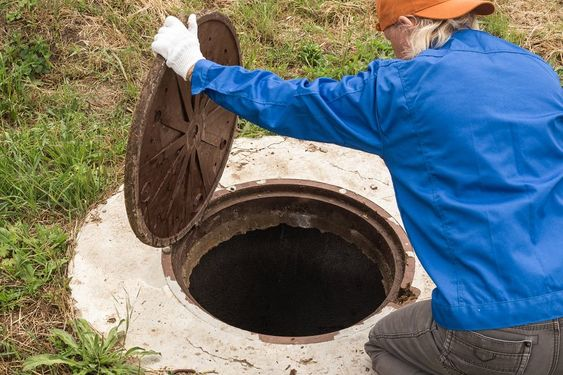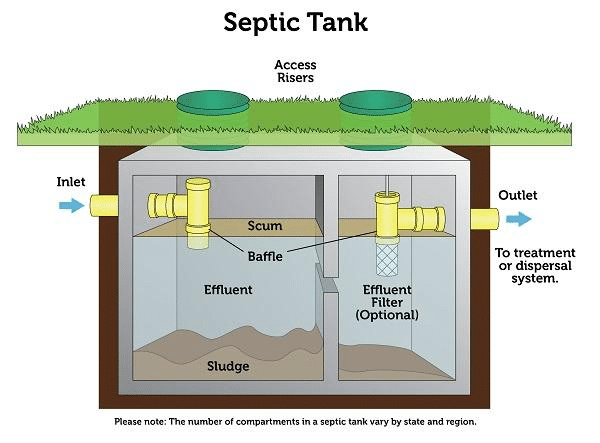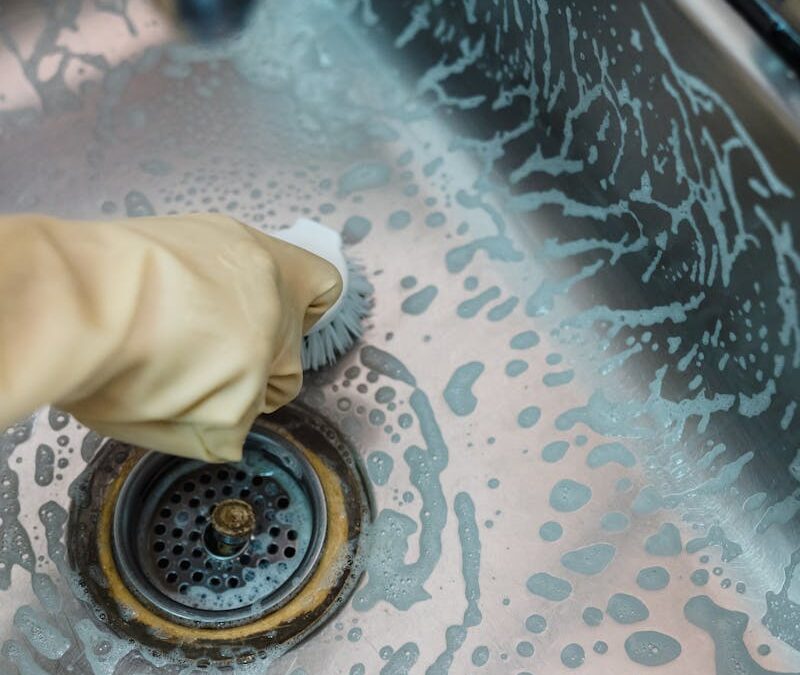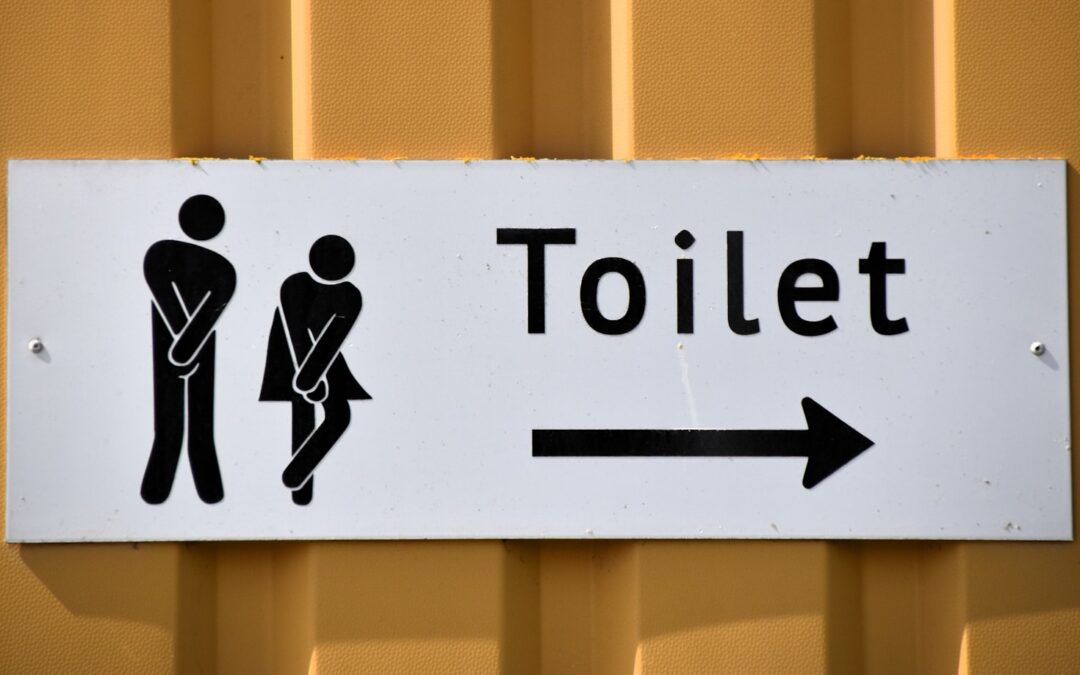A septic tank is a crucial component of any property’s septic system. It is responsible for storing solid waste, breaking it down naturally, and then sending the wastewater through perforated pipes in your yard to be dispersed into the ground.
Understanding how septic tanks work—and how they should be maintained—is essential for property owners.
This article will discuss the basics of septic tanks and how they function so that you can ensure yours is operating safely and effectively.
Schedule Service Online
Get a free estimate so you know what you're signing up for
"*" indicates required fields
For Emergency Services Call: 410-255-9300
Components of Conventional Septic Systems
A conventional septic system includes several important components that work together to process the wastewater from your property. These are the inlet pipe, outlet pipe, septic tank, scum layer, sludge layer, effluent layer, baffle wall, vent pipe, distribution box, and drain field.
Inlet Pipe: The pipe is responsible for transporting wastewater from your home or office to the septic tank.
Outlet Pipe: This connects the septic tank to the distribution box and drain field, allowing effluent to move through them.
Septic Tank: The septic tank is a large, water-tight container that holds solid waste particles in anaerobic conditions. Bacteria break down the waste and transform it into liquid byproducts called effluent. Inside the tank are three layers—the scum layer on top, the sludge layer at the bottom, and the effluent layer between them.
Baffle Wall: A baffle wall is a divider inside the septic tank that separates incoming wastewater from leaving effluent and helps keep solids from entering the drain field.
Vent Pipe: This pipe serves as an outlet for gases created during the wastewater treatment process, allowing them to escape out of the tank rather than building up inside it.
Distribution Box: A distribution box distributes effluent evenly throughout the drain field via perforated pipes.
Drain Field: The final component in a septic system is the drain field, which comprises perforated pipes that allow the treated effluent to disperse into the ground, where further filtration and treatment can occur naturally.
How Does a Septic Tank Work?
Septic tanks are typically constructed of concrete, fiberglass, or polyethylene and consist of two or three main chambers. In simple words, a septic tank works by using a type of bacteria to break down organic matter such as food and grease, and separating the solid waste from the wastewater. Let’s take a look at this in more detail.
Solid Wastes
The first chamber is where household waste enters the septic tank, and it is here that the solids begin to settle out. In this chamber, solid wastes are separated from wastewater by a layer of scum, and anaerobic bacteria (microorganisms) break down the organic matter from household waste.
Effluent
The effluent, or wastewater, then passes into the second chamber for further treatment. Here, additional clarification occurs as more solids settle and lighter materials, such as fats, rise to the top. This clarifies and purifies the effluent before moving it to a drain field for final disposal.
Scum
As mentioned earlier, a scum layer forms at the top of each chamber in a septic tank. This scum layer is composed of light materials such as fats, oils, and household detergents, which are too light to settle in the first chamber. The scum layer is trapped by an outlet pipe at the top of the tank and remains there until it’s pumped out during a septic service.
At the end of the process, the anaerobic bacteria in septic tanks help break down harmful coliform bacteria, which can cause health problems if left untreated. As wastewater percolates through the drain field, it continues to be treated by these bacteria and is eventually released into the environment.

Types Of Septic Systems
Although almost all septic systems work the same way, some may differ depending on the type of septic system on the property. Some of the most common types of septic systems and tanks include:
Standard Septic Tanks
Standard Septic Tanks are the most commonly used system for residential properties. It is a conventional, gravity-fed system that relies on natural anaerobic bacteria to break down waste and can be easily maintained with regular pumping services.
Standard septic tanks come in various sizes depending on how many people live in your home but typically range between 1,000 and 2,500 gallons in capacity.
Aerobic Septic System
An Aerobic Septic System is an advanced septic tank designed to treat wastewater more quickly by relying on oxygen instead of naturally occurring bacteria. This process uses aeration and biological treatments to break down the organic material in wastewater faster, resulting in a cleaner effluent that can be discharged into a drain field much sooner than with a standard septic system.
Aerobic tanks are the best option if you want a faster wastewater treatment process but require more maintenance than a standard septic tank.
Mound Septic System
A Mound Septic System is a standard septic tank modified with additional drain field piping and layers of gravel to allow wastewater to percolate into the ground more effectively. These systems are best suited for areas with shallow soils or high water tables because they can provide better treatment.
Underground Septic Tank
An underground septic tank is an in-ground septic system that can be installed almost anywhere on a property. These systems are usually preferred for areas with limited space since they don’t require additional excavation and have the same capacity as standard septic tanks.
Sand Filter System
A Sand Filter System is designed to improve wastewater quality even further by filtering effluent through multiple layers of sand and gravel before it is discharged into a drain field. This system requires more maintenance than other septic tanks and may require chemicals to maintain optimal water quality.
Drip Distribution System
The drip distribution system consists of drip lines in trenches filled with gravel that evenly distributes wastewater into the soil. This type of system is ideal for properties with limited space as it requires less land area than traditional systems.
Community Septic System
A community septic system or cluster tank is designed to serve several homes at once and can be a cost-effective solution for densely populated areas.

Septic System Maintenance
Regular maintenance of your septic tank system is essential for its proper functioning. This involves having a qualified professional inspect your tank every 3-5 years to ensure all components are in working order and emptying solid waste accumulated over time.
However, you can take the following measures to maintain your septic tank capacity and ensure that the septic tank works effectively.
Empty Solid Waste That Has Accumulated Over Time
Solid wastes are the most common cause of clogs and blockages in a septic tank. These wastes include kitchen grease, paper towels, diapers, and other items that are not biodegradable. Over time, these materials can accumulate in the tank, leading to blockages and poor system performance. Having your septic tank pumped out regularly is important to prevent this from happening.
Use Eco-Friendly Detergents
Using eco-friendly detergents in washing machines can help reduce the amount of detergent residue that accumulates in your tank over time. These detergents do not contain phosphates which bind with other substances such as calcium and magnesium, leading to sludge accumulation in your septic tank.
Using eco-friendly detergents also helps keep harmful toxins from entering the environment when wastewater is released into the ground or water bodies nearby.
Use Water Efficiently
Using water efficiently can also help reduce strain on your septic tank system. Ensure to use appliances such as washing machines and dishwashers only when full, and avoid long showers or baths that use more water than necessary.
Additionally, you should check for any leaks in your plumbing fixtures, as this will lead to an excess of wastewater going into the tank, leading to a higher risk of clogging and blockages.
Recycle Greywater
Using water efficiently also involves recycling greywater, the wastewater generated from showers, washing machines, and dishwashers. This type of wastewater is usually clean enough to be reused for irrigation, toilet flushing, and other non-potable water uses.
Recycling greywater can help reduce the amount of wastewater that goes into your septic tank, reducing the chance of blockages and improving its performance.
Install Aerobic Bacteria Treatment Systems
Aerobic bacteria treatment systems are designed to help break down organic matter in your septic tank, speeding up the decomposition process. These systems use oxygen to stimulate the growth of beneficial bacteria that can reduce the amount of solid waste buildup inside the tank and ensure that wastewater is properly treated before being released into the environment.
Installing this system can help you reduce the risk of your septic tank system malfunctioning and ensure a longer life span.
Have A Qualified Professional Inspect Your Tank
Having a qualified professional inspect your tank regularly is essential to ensure that all the components of your septic tank system are in proper working order. This inspection should involve an experienced technician examining the tank and its ancillary components, such as the distribution box, pump chamber, and control panel.
They should also check for any signs of leakage, blockages, or other issues that may be present such as cracks in pipes or tanks; root growth near drain fields; standing water in areas where it shouldn’t be; odors coming from the system; and backups into fixtures or drainage points.
Conclusion
Septic tank repair bills can cost up to thousands of dollars. By understanding how septic tanks work and how to maintain them, property owners can reduce a bunch of the costs associated with a septic system.
For your sewer installation and maintenance needs, rely on MD Sewer & Plumbing services as your top choice – our experienced technicians will provide quality service promptly. Contact us today to book a consultation.




